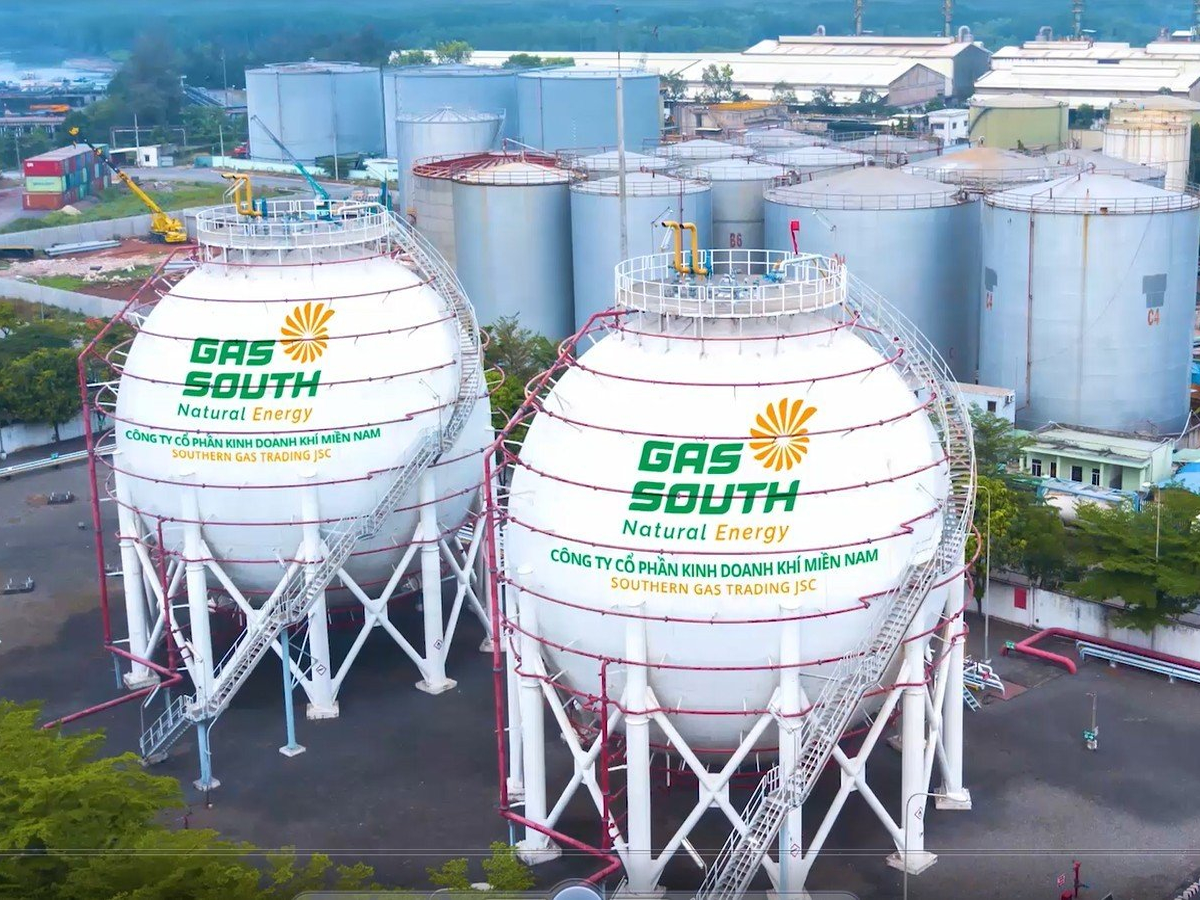Liquefied Petroleum Gas (LPG) is a widely used fuel in various sectors, including residential, commercial, and industrial. What exactly is LGP, what are the components, and how is it used? In the article that follows, let's learn more about Liquefied Petroleum Gas (LPG) with Gas South!
1. An overview and description of liquefied petroleum gas (LPG)
1.1 What is LPG?
LPG - Liquefied petroleum gas, is a liquefied form of petroleum gas (commonly known as gas). It is composed of various hydrocarbon gases, with propane (C3H8) and butane (C4H10) being the primary components. These gases can be blended or stored separately during production. Commonly, propane and butane are blended in ratios of 50:50, 40:60, and 30:70

LPG - Liquefied Petroleum Gas is widely used in the world
LPG is a product obtained during the processing of natural gas or the refining of crude oil. Since LPG can liquefy at room temperature under moderate pressure, LPG is often referred to as "Liquefied Petroleum Gas". Dr. Walter Snelling conducted the initial study and production of liquefied petroleum gas (LPG) in 1910. Two years later, commercial LPG goods started to appear. LPG is currently one of the fuels that is widely used around the world.
Read more: What is liquified natural gas mean? Oppotunities and challenges of LNG in Viet Nam
1.2 Liquefied petroleum gas (LPG) characteristics
LPG is a colorless gas, about 1.85 times heavier than air (in its gaseous state and at 150 degrees Celsius) and about 0.55 times lighter than water (in liquid form below 150 degrees Celsius). As a result, when released, LPG tends to accumulate in enclosed, low-lying or confined areas. In its pure form, LPG is odorless, but during production, a substance called Mercaptan is added to facilitate the detection of LPG leaks by odor.
LPG can rapidly convert into a gaseous state at temperatures above 0 degrees Celsius or under atmospheric pressure. On average, 1 liter of liquid LPG can expand into 250 liters of gas, resulting in significant and rapid amplification. LPG can form highly explosive mixtures. When ignited, LPG can generate extremely high temperatures (over 1,900 degrees Celsius) and release approximately 12,000 kcal of energy per kilogram of fuel. This energy level is equivalent to about 1.3 liters of heating oil, 1.5 liters of gasoline, or over 2 kg of coal when completely burned.

LPG - Liquefied petroleum gas can be used as a cooking fuel
1.3 Liquefied petroleum gas (LPG) classification
There are now three specific types of LGP in use across the globe:
-
Clean LPG: Produced from advanced oil refineries, it does not contain impurities and has a relatively higher cost.
-
Low-quality LPG: Produced in relatively older oil refineries, it often contains impurities (olefins) and costs less.
-
Blended LPG: Produced by blending various types of low-quality gases, they are of lower quality and sold at a very low cost.
1.4 LPG production process
LPG is typically generated in high-tech oil refineries or natural gas refineries using the following three steps:
-
Step 1: Gas Cleaning - The extracted natural gas or associated gas from gas fields or oil wells is brought up for cleaning through filtration methods. At this stage, impurities are completely removed, resulting in a mixture of hydrocarbons (methane, ethane, propane, etc.).
-
Step 2: Gas Separation - Various gas separation methods, such as compression, absorption, or cooling, separate each type of gas from the hydrocarbon mixture obtained in Step 1.
-
Step 3: Blending - The separated liquefied butane and propane are blended in appropriate proportions to meet different demands (e.g., 30:70 and 40:60 ratios are used for cooking fuel, 50:50 is used for battery production fuel, etc.).
2. Application of LPG in daily life
Burning LPG emits extremely little greenhouse gas, making it a steadily more environmentally friendly source of raw materials and widely used, specifically:
-
Residential Use: Liquefied Petroleum Gas (LPG) is commonly compressed into 12 kg gas cylinders and used as a fuel for cooking and heating in households.
-
Commercial Use: Large restaurants, hotels, and entertainment centers often use industrial-sized gas cylinders weighing between 20 and 45 kg for cooking and heating purposes.
-
Industrial Use: In various industrial sectors, LPG is utilized as fuel in production activities such as brick making, ceramics, pottery, glass manufacturing, agricultural and aquaculture processing, and food processing. Additionally, LPG is also used as a refrigerant substitute for CFCs (chlorofluorocarbons) to minimize harmful effects on the ozone layer.
-
Transportation: LPG can be used as an efficient alternative fuel for gasoline and diesel, offering fuel cost savings of around 25-30% and reducing greenhouse gas emissions from vehicles.

LPG - Liquefied Petroleum Gas is utilized as an alternative to both gasoline and oil as a fuel.
3. An introduction to Gas South - Southern Gas Trading Joint Stock Company - a leading LPG supplier
Gas South, the Southern Gas Trading Joint Stock Company, is one of the largest producers and distributors of liquefied petroleum gas (LPG) in the Vietnamese market. With over 23 years of experience and an extensive distribution network spanning from Ca Mau to Nghe An, Gas South owns a range of well-known domestic LPG brands, including:
-
Dak Lak and Dak Nong: These regions mainly distribute Dak Gas cylinder brands.
-
Gia Lai and Kon Tum: You will find a primary focus on the distribution of Dang Phuoc Gas.
-
Tay Ninh, Tien Giang, and Long An: The preferred choice in these areas revolves around JP Gas cylinder brands.
-
Vung Tau and Binh Thuan: The AGAS brands take center stage in distribution.
-
The VT-GAS and Gas Dau Khi cylinder brands have widespread distribution coverage from Ca Mau to Nghe An.

Gas South is the leading LPG supplier in Vietnam
Gas South presently provides industrial LPG through two primary channels, in addition to the brands of civil gas cylinders: bottled LPG systems and specialized LPG tank trucks. With a closed production process and strict quality control system, Gas South is always prepared to advise, design, install, direct use of, and maintain the system to enable clients to always achieve the best LPG usage efficiency. To receive detailed LPG pricing, customers can directly contact Gas South through the following channels:
-
Head office: 4th Floor, PetroVietnam Tower, 1-5 Le Duan, Ben Nghe, District 1, Ho Chi Minh City
-
Phone number: 028.3910 0108 - 028.3910 0324
-
Email: lienhe@pgs.com.vn
-
OA Zalo: https://zalo.me/gassouth18006776
The above is an overview article about what LPG is, its composition, and its applications in daily life. We hope that the information provided by Gas South in the article has helped customers gain a better understanding of LPG. Customers and partners who require further information or wish to place an order for LPG are encouraged to directly contact Gas South through the aforementioned communication channels for consultation and detailed pricing.





